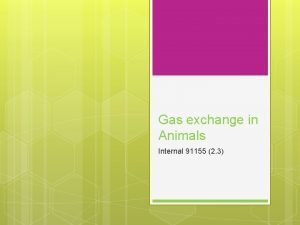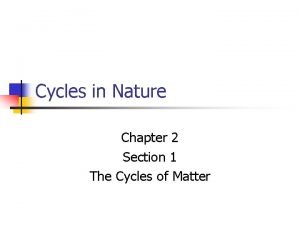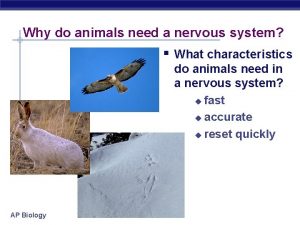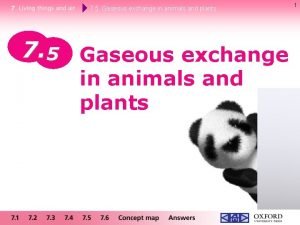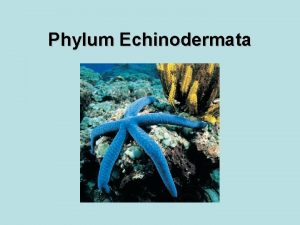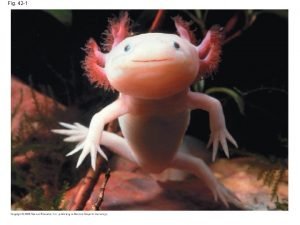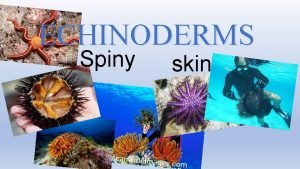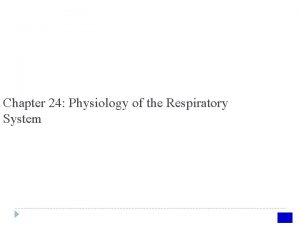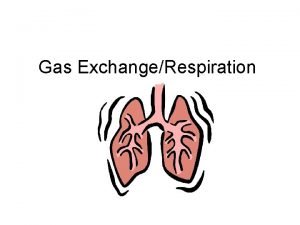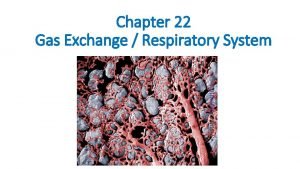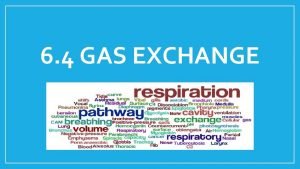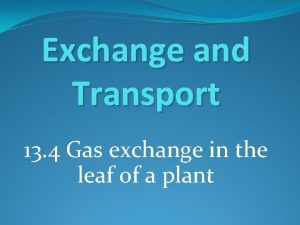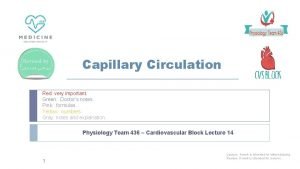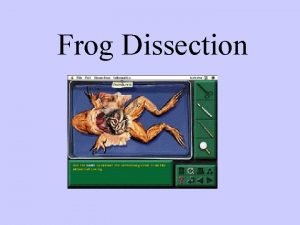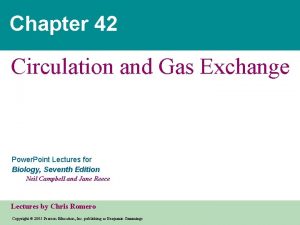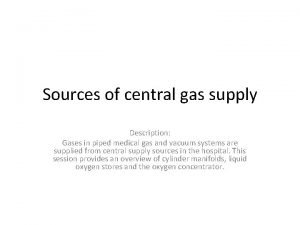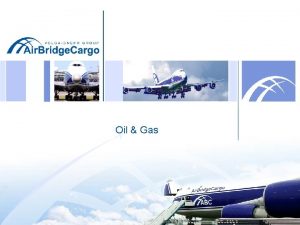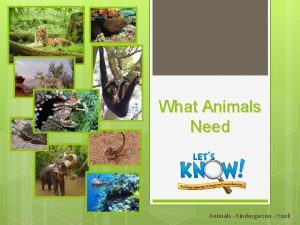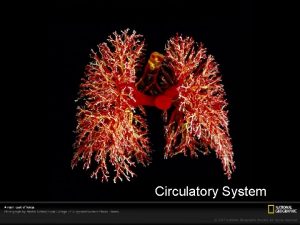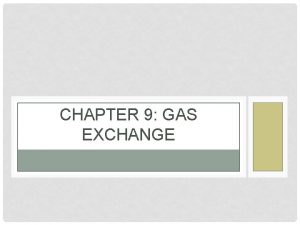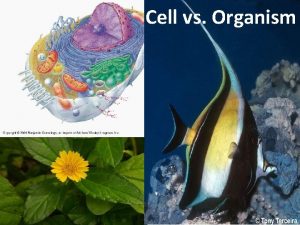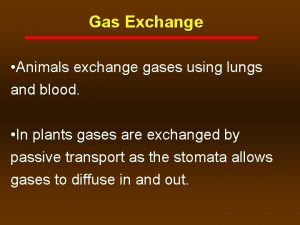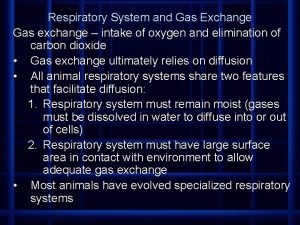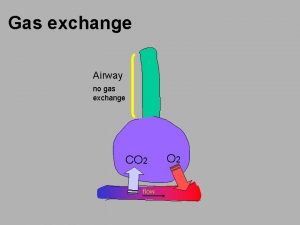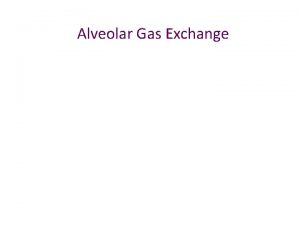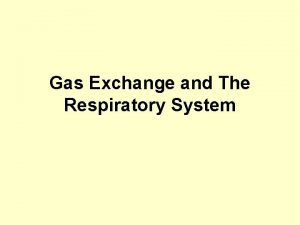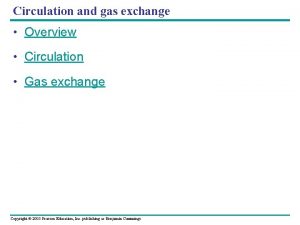Gas Exchange Animals need a supply of O








































- Slides: 40

Gas Exchange

• Animals need a supply of O 2 and a means of expelling CO 2 • They are the reactants and products of cellular respiration Burning man

Respiratory medium • Atmosphere has O 2 at a partial pressure of ~159 mm. Hg – Varies with altitude, about 1/2 that 18, 000 feet • Water ~ 1 ml of O 2 per 100 ml of H 2 O at 0 o Celsius – Varies with soluability, pressure, salts, and temperature – 0. 7 ml of O 2 per 100 ml of H 2 O at 15 o Celsius – 0. 5 ml of O 2 per 100 ml of H 2 O at 35 o Celsius

Water vs. air as a medium • Water • Keeps the cells moist • Lower oxygen concentration than air • Concentration varies more • Water is heavier • • • Air Higher conc. of O 2 Faster diffusion Needs less ventilation Water is lost by evaporation • So lungs have to be interior


Diffusion • Cells are aquatic • O 2 has to be dissolved across a respiratory surface to get to cells • O 2 can diffuse through a few mm of cells • If a part of your body is more than a few mm thick then you need a way to carry the oxygen • Need a large respiratory surface area

• Skin breathers • Earthworms – Keep moist skin and exchanges gas across its entire surface • Amphibians – Supplement their lungs/gills

Form and function • Depends on terrestrial/aquatic environment • Simple animals have nearly every plasma membrane in contact with the outside environment – Protozoans – Sponges – Cnidarians – Flat worms

• Lungs/gills – Highly folded or branched body region – Allow a large surface area • Gills – External – Problem of losing water due to osmolarity • Lungs – Internal – Allow use of air as a medium – Terrestrial life poses problem of dessication

Gills • Invertebrates can have simple gills – Echinodermata: have simple flaps over much of their body – Crustaceans: have regionalized gills • Ventilation: have to keep water moving over the gills, either by paddling water in or staying on the move – This requires energy – Gill slits of fish are believed to be evolutionary ancestors of Eustachian tubes

Gills in a Tuna head




Invertebrate gills

Countercurrent exchange • Speeds transfer of O 2 to blood • Blood and water move toward each other in gills so as blood is more loaded with O 2 its running into water with even more O 2 dissolved so it can take on the maximum load – Gills can remove 80% of the oxygen from the water passing over it

Tracheae • Spiracles are holes all over an insects body. • From the spiracles, tubes branch out • Finest branches (0. 001 mm) reach every cell • Insects still have circulatory system to carry other materials



Giant insects • By flexing they compress and expand the tracheae like a bellows • However insects can’t be too big because the oxygen can’t diffuse far enough • But ancient insects were large. How?

Lungs • Dense networks of capillaries under epithelium forms the respiratory surface • Snails: Internal mantle • Spiders: book lungs • Frogs: balloon like lungs • Vertebrates: Highly folded epithelium – Humans (~ 100 m 2 surface area)

Lungs • Enclosed by double walled sac whose layers are stuck together by surface tension, allowing them to slide past each other • System of branching ducts • Nasal cavity pharnyx open glotis larynx (voicebox) trachea (windpipe) 2 bronchi (bronchus) many bronchioles cluster of air sacs called alveoli (alveolus)



Ventilating the Lungs • Frogs use Positive pressure breathing: gulp air and push it down • Mammals: negative pressure breathing – Suction pulls air down into a vacuum – During exercise rib muscles pull up ribs increasing lung volume, and lowering pressure – But ribs are only ~ 1/3 of Shallow breathing

Diaphragm • Sheet of muscle at bottom of thoracic cavity • During inhalation: it descends • During exhalation: it contracts


volumes • Tidal volume: The volume of air inhaled/exhaled – ~500 ml in humans • Tidal capacity: maximum volume – ~3400 ml for girls 4800 ml for boys • Residual volume: air left in alveoli after exhalation

Control • Medulla oblongata/ pons – Negative feedback loop: when stretched too much lungs send message back to brain to exhale – CO 2 levels are monitored in brain • CO 2 dissolves in water and forms carbonic acid with sodium carbonate salts • More carbonic acid lowers p. H and the medulla responds by increasing depth and rate of breathing

Hyperventilating • Trick the brain by purging blood of CO 2 so breathing slows

Loading/Unloading gases • • • Substances diffuse down the Conc. Grad. In the atmo. There’s 760 mm. Hg of gas O 2 is 21% of this so 0. 21 x 760 = 159 This is the partial pressure of oxygen PO 2 CO 2 partial pressure(PCO 2): 0. 23 Liquids in contact with air have the same partial pressure

• Blood at lung: high PCO 2 and low PO 2 • At lungs CO 2 diffuses out and O 2 diffuses in • Now blood has a low PCO 2 and high PO 2 • In cells doing respiration there is a high PCO 2 and low PO 2 so the CO 2 diffuses into blood and O 2 diffuses into the cells


Respiratory pigments • Colored by metals • Invertebrates have hemocyanin which uses copper making blood blue • Vertebrates: hemoglobin uses iron to carry the oxygen. Each hemoglobin carry 4 O 2 s, each blood cell has many hemoglobins

If blood is red why do your veins look blue? • Blood = red in its oxy’d form (i. e. , leaving the lungs), – hemoglobin is bound to oxygen to form oxyhemoglobin. • dark red in deox’d form (i. e. , returning to the lungs), – hemoglobin is bound to carbon dioxide to form carboxyhemoglobin. • Veins appear blue because light, penetrating the skin, is absorbed and reflected back to the eye. • Only higher energy wavelengths are seen. And higher energy wavelengths are what we call "blue. " • From straightdope. com


Dissociation curves • Changes in PO 2 will cause hemoglobin to pick up or dump oxygen • Lower PO 2 means hemoglobin will dump oxygen • Bohr shift: Drops in p. H makes hemoglobin dump O 2

Diving mammals • • Weddell seals Dive 200 – 500 m 20 min – 1 hr. under water Compared to us it has ~ 2 xs as much O 2 per kg of wieght • 36% of our O 2 is in lungs 51% in blood • Seals have 5% and 70% respectively – more blood, huge spleen stores 24 L blood – More myoglobin (dark meat) – Slow pulse

Liquid Breathing • Perfluorocarbon liquids • ~65 m. L O 2 per 100 m. L • Problems with expelling the CO 2 • Remember this is a liquid 1. 8 times as dense as water so it is hard to breath • Could someday be used for diving, or medical applications

 Gas exchange key events in gas exchange
Gas exchange key events in gas exchange Gas exchange in plants and animals venn diagram
Gas exchange in plants and animals venn diagram How do plants get nitrogen
How do plants get nitrogen How do animals get the nitrogen they need
How do animals get the nitrogen they need Why do animals need a nervous system
Why do animals need a nervous system Https//a-z-animals.com/animals
Https//a-z-animals.com/animals Is a horse a producer consumer or decomposer
Is a horse a producer consumer or decomposer Which energy
Which energy Animals that eat both plants and animals
Animals that eat both plants and animals Gaseous exchange in animals
Gaseous exchange in animals Real exchange rate formula
Real exchange rate formula Voluntary exchange activity the pearl exchange
Voluntary exchange activity the pearl exchange Gas exchange oxygen transport
Gas exchange oxygen transport Phylum
Phylum Fig 42
Fig 42 Countercurrent exchange in fish
Countercurrent exchange in fish What is a echinoderm
What is a echinoderm Pulmonary gas exchange and transport diagram
Pulmonary gas exchange and transport diagram Skin gas exchange
Skin gas exchange Xerophyte adaptations
Xerophyte adaptations Gas exchange
Gas exchange How is amoeba adapted for gas exchange bbc bitesize
How is amoeba adapted for gas exchange bbc bitesize Gas exchange
Gas exchange Impaired gas exchange subjective data
Impaired gas exchange subjective data Porifera
Porifera Gas exchange
Gas exchange Capilary beds
Capilary beds Pathway of air in respiratory system
Pathway of air in respiratory system Image
Image Chapter 42 circulation and gas exchange
Chapter 42 circulation and gas exchange Chapter 5 section 1 supply
Chapter 5 section 1 supply Ratio ng elastisidad
Ratio ng elastisidad Matching supply and demand in supply chain
Matching supply and demand in supply chain Unregistered gas meter
Unregistered gas meter Central gas supply
Central gas supply Oil and gas supply chain challenges
Oil and gas supply chain challenges Pseudo reduced specific volume
Pseudo reduced specific volume Imaginary gas
Imaginary gas Gas law
Gas law Ideal gas vs perfect gas
Ideal gas vs perfect gas Reason of bhopal gas tragedy
Reason of bhopal gas tragedy

